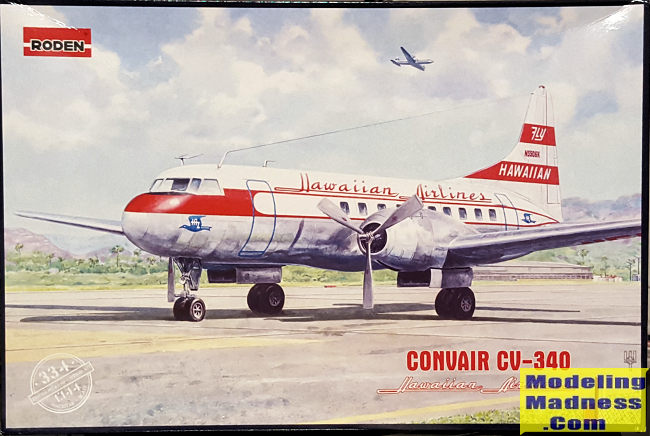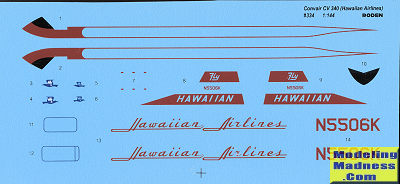
Roden 1/144 Convair CV-340
| KIT #: | 334 |
| PRICE: | $25-30.00 shipped from various sources |
| DECALS: | One option |
| REVIEWER: | Scott Van Aken |
| NOTES: | 2019 tooling |

| HISTORY |
The design began with a requirement by American Airlines for an airliner to replace its Douglas DC-3s. Convair's original design, the unpressurised Model 110, was a twin-engine, low-wing monoplane of all-metal construction, with 30 seats. It was powered by Pratt & Whitney R-2800 Double Wasp radial engines. It had a tricycle landing gear, and a ventral airstair for passenger boarding. The prototype Model 110, registration NX90653, first flew on July 8, 1946. By this time, American Airlines had changed the requirements to include pressurization and deemed the design too small. Convair used the first prototype for 240 series development work before it had it broken up in 1947.
To meet the requirements of airlines for a pressurized airliner, Convair produced a revised design—the Model 240. This had a longer but thinner fuselage than the Model 110, accommodating 40 passengers in the first pressurized, twin-engined airliner. The 240 first flew on March 16, 1947.
The Model 240 was followed by the Model 340, which had a longer fuselage, longer-span wings, and more powerful engines. The 340 first flew on October 5, 1951. In 1954, in an attempt to compete with turboprop-powered airliners like the Vickers Viscount, Convair produced the Model 440 Metropolitan, with more streamlined cowlings, new engine exhausts, and better cabin soundproofing. As the "Super 240" evolved into the CV-340 and CV-440, the design reached the limit of piston-engine performance, and future development centered on conversion to turboprop power.
Built for United Airlines and other operators including KLM, the CV-340 was a CV-240 lengthened to hold an additional four seats. The wingspan was extended for better performance at higher altitudes. The CV-340 replaced the DC-3 in United service. The airline flew 52 340s for 16 years without a fatality. KLM operated the type from early 1953 until mid-1963. Many CV-340 aircraft were converted to CV-440 standard.
| THE KIT |
 Roden
has, in the last several years, provided 1/144 modelers with kits that have been
on want lists for quite some time. This latest kit follows in that philosophy
and will undoubtedly be boxed in several liveries. This should be a major money
maker for the company as the number of liveries available for this aircraft are
considerable.
Roden
has, in the last several years, provided 1/144 modelers with kits that have been
on want lists for quite some time. This latest kit follows in that philosophy
and will undoubtedly be boxed in several liveries. This should be a major money
maker for the company as the number of liveries available for this aircraft are
considerable.
Roden has chosen to go the 'clear windows' route with this kit. This will please a segment of the airliner hobby who likes this method and cause additional work for those who prefer a smooth fuselage with decals for the windows. The latter method allows for a variety of window patterns while the initial method requires either filling or additional windows being cut. I prefer the decal method.
Some 1/144 aircraft model companies provide a rudimentary cockpit. Roden does not, having only a nose gear well floor. It would probably be useful to put in a bulkhead if for no other reason, to keep weight in place. The instructions recommend 5 grams to keep from tail sitting. The instructions also recommend gluing the two piece horizontal stabs to each fuselage half as well as the windows prior to cementing the fuselage together.
Nose gear is fairly complex consisting of seven pieces if one includes the wheels and floor. Main gear are simply a strut, oleo scissors and two wheels. The kit provides two noses, one is a longer radar nose for a future boxing. Wings are a single lower piece with upper halves. The engine cowlings are a single piece into which one puts the engine face. If you want the prop to spin, that has to be installed prior to cementing to the wings.
Once the wings are assembled, it is attached to the fuselage and the gear doors installed. There are no antennas included so you will need to add whatever may be needed.
 Instructions
are well drawn and you are provided livery for one aircraft, that being a
Hawaiian Airlines plane from 1956. A full color exterior painting and markings
sheet is provided. The decals are a little thick and very glossy. Entry doors
and an anti-glare panel are included on the sheet. Using this livery will
require some careful masking. Fortunately the majority of the area that gets
decals is white. The decals are on a blue background and this shows that the red
will be somewhat transparent (as in it is not backed by white as you find on
quality decals). Roden decals have a less than stellar reputation so unless
something has changed, you may wish to consider aftermarket.
Instructions
are well drawn and you are provided livery for one aircraft, that being a
Hawaiian Airlines plane from 1956. A full color exterior painting and markings
sheet is provided. The decals are a little thick and very glossy. Entry doors
and an anti-glare panel are included on the sheet. Using this livery will
require some careful masking. Fortunately the majority of the area that gets
decals is white. The decals are on a blue background and this shows that the red
will be somewhat transparent (as in it is not backed by white as you find on
quality decals). Roden decals have a less than stellar reputation so unless
something has changed, you may wish to consider aftermarket.
| CONCLUSIONS |
I am pleased to see this aircraft released. It provides a basis for a fairly large number of civilian and military liveries. Despite Roden having been around for a fairly long time, it is best to treat their kits like short run. Many of the smaller parts have some flash and others have the usual mold seams that will have to be dealt with. This kit seems to be selling fairly well as there are retailers who have sold out. We can expect a military C-131 in the near future and possibly Roden will kit the turboprop versions, like the CV-580 with the larger fin/rudder and modified horizontal stabs.
| REFERENCES |
https://en.wikipedia.org/wiki/Convair_CV-240_family
January 2020
Copyright ModelingMadness.com. All rights reserved.
If you would like your product reviewed fairly and fairly quickly, please contact the editor or see other details in the Note to Contributors.
Back to the Main Page Back to the Previews Index Page Back to the Review Index Page